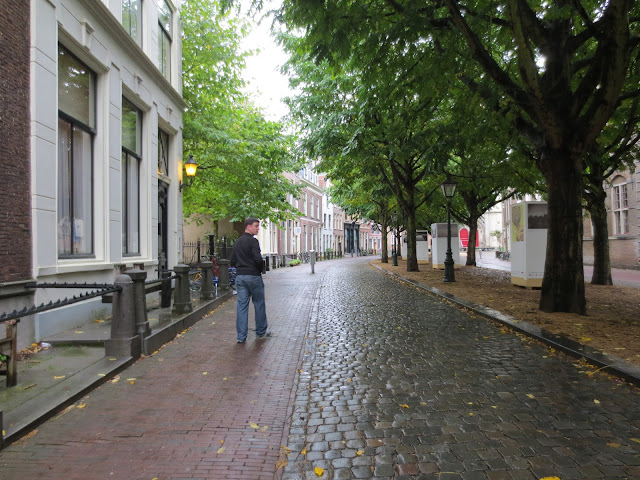Maastricht isn't just picturesque, it's full to the brim with history because it has had 'uninterrupted inhabitation' since Roman times. This wall for instance, was put in place by the Romans, but the Medieval inhabitants kept it up and added their own touches (like the tower).
The oldest town gate in The Netherlands. This gate, called The Helpoort has been standing since the 1200's. How's that for Medieval?
The outside is incredible, but what was more incredible to me was that the inside is still sound enough to house a museum and withstand the tourists that climb the stairs (according to the sign: at their own risk).
If you stroll just around the corner from the Helpoort you will see this charming little avenue . . .
. . . and this delightful view. The red and white shutters are my favorite part of this picture, but the most impressive part of the picture is that those homes have been inhabited longer than the United States has been a country. On the right you can see a fragment of the Medieval wall.
I have no idea how old this building actually is, but it seems to be playing up the Medieval theme of the town.
And I'm not sure how many years this Roman has seen, but he's a great reminder of the town's origins.
The observant among you have noticed the wrought iron 'x's on this building and the previous picture. In fact, the observant among you would have noticed them on many, many buildings through out Maastricht. I happen to be an observant one and so I tried to find the reason for them. The answer I found was: they hold the building together.
????
There is a beam that runs along the house that then sticks out enough for an 'x' to loop it so that your house stays together. I'd think that it was pretty questionable engineering if the buildings hadn't been standing since the 1700's or so.
This mill has been turning for a loooooong time. We watched its slow steady turn for a few minutes, then we went in search of the fruits of its labor.
Spelled: vlaai. Pronounced: fly. Tasted: spectacular.
This is a local bakery specialty and basically it is a shallow pie (this one happens to be apple/apricot) that all of the locals eat with their coffee. We only tried one bakery, but I think it is fairly safe to say that the mill ground wheat makes phenomenal vlaai crust.
~~~~~~~~~~~~~~~~~~~~~~~~~
In the heart of Maastricht there is the only 'sepulcher church' in The Netherlands. This means that is it the only church in The Netherlands to have been built on the grave of a saint of the Holy Roman Catholic Church. In 384 A.D. St. Servatius died and his grave made the spot 'holy' and centuries after his death the building of this big beautiful cathedral began.
One of the entrances to the St. Servatius church. We're not in Protestant country here-- although the church is pre-protestantism.
Unusual for churches in The Netherlands, but common for cathedrals, this church has a courtyard with an enclosed hallway that boxes it in. That's why there is light flooding in from the right hand side.
A glimpse of the fresco ceiling. Another rarity in The Netherlands.
Another entrance to the St. Serveas Cathedral, after touring Protestant churches in The Netherlands this is fairly awe-inspiring elaborate decoration.
When you are a saint you have the chance that you will be immortalized in gold even though you may not actually look anything like the bust because people 600+ years after your death probably can't remember what you look like.
Gold plated box for holding relics.
Treasury display room in the Cathedral of St. Servatius, impressive for a place as small as Maastricht. Connected to it was a display of impressive old textiles and other interesting things like the graves beneath the church.
-------------
More to come . . .
































































